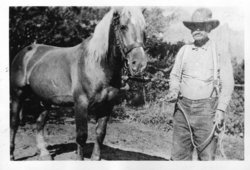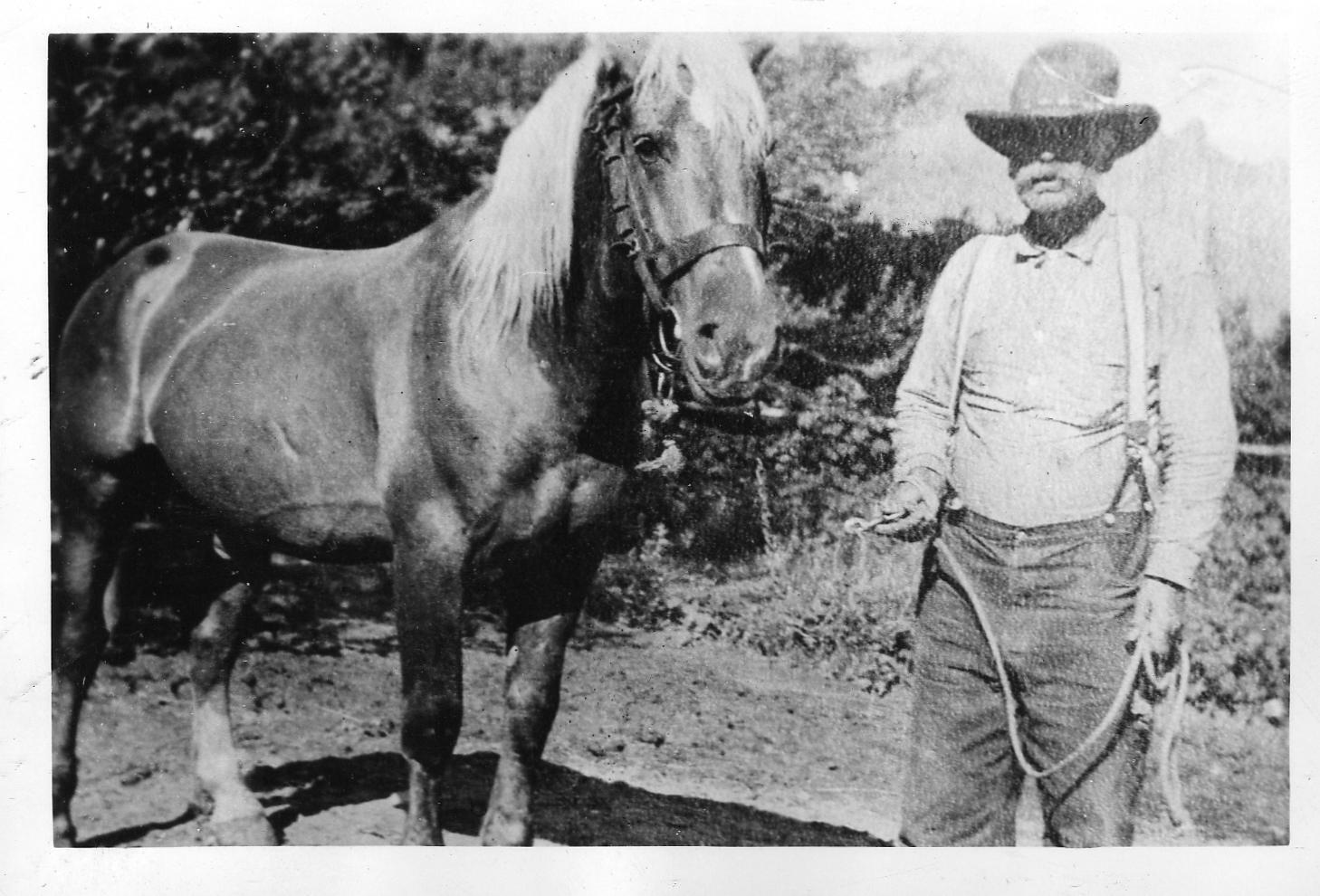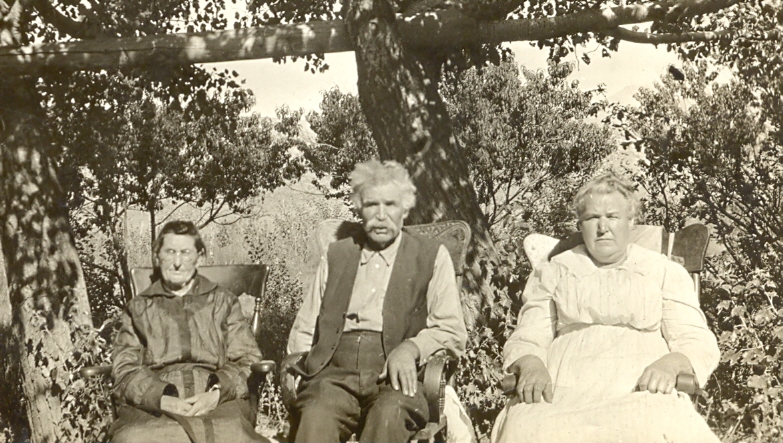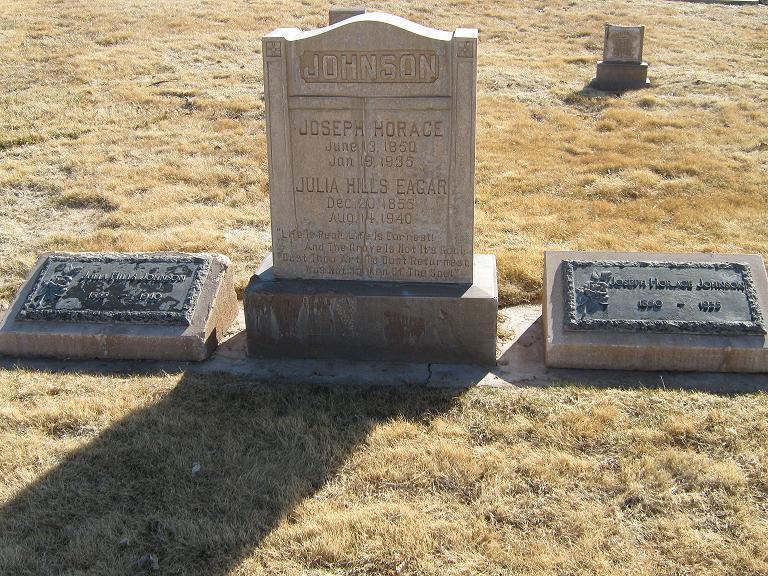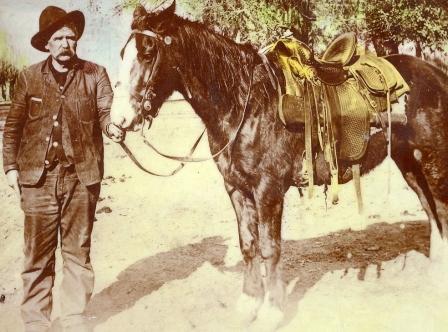The family stayed in Salt Lake for a short time. His father's mission was to help build new towns. They moved a great deal when he was young. They moved to Springville and lived there about three years. They then moved to Payson and then a short distance to Santaquin. This was abandoned because of Indian difficulties. The next move was to Cedar City. They built a fort there and stayed for a number of years. Horace attended his first school there. After several years, the family moved to Sanpete County. At Uintah Springs, now called Fountain Green, George Washington Johnson, Amos and Horace Johnson, James Holman, Silas and Sanford Holman were the first six men to build houses there. Horace was about 15 or 16 years of age then. They cleared land for farms and built a settlement. Here Horace attended his last school.
During the Black Hawk War, Horace was an express rider, as well as an Indian interpreter. Ranger, a Morgan mare, and Jingle Bob were the horses of his express string. When the railroad was being built through Weber Canyon in 1867, he worked on the railroad until April of 1868 when he and a couple of friends went to Nevada to join in the White Pine Gold Rush. He returned to Mona in the fall of 1869 and worked on the railroad again and was preparing to go back to Nevada. His plans and life were changed when he fell in love with and married Julia Hills Eagar, his second cousin. They were married August 25, 1870, by his father in his home in Mona, Utah. There were about 150 guests at the wedding.
It was the custom at that time for the groom to bear all the expenses of the wedding. Horace took the money he saved to go back to White Pine and used this money to pay for the wedding. It was also not the custom to give wedding presents at that time. The couple was expected to start out on "their own hook." His mother gave him a present—a lead pencil and some of the best advice anyone could receive—"keep your accounts straight in life."
The first year of their marriage, Horace worked on the stage line and in Tintic. When they were married almost a year, a baby daughter was still-born. Julia was very ill. Horace became concerned about her condition, especially when his grandmother warned him that Julia might die if he left her alone while he was on his job at Tintic. He took her with him. She was so weak that he had to carry her around for a week or ten days. He would carry her to a spring seat by the fire, fix their meals, then carry her to bed. She began to improve and in a week or so she was able to do the cooking. They had to leave Tintic because the smelter closed. The operators swindled people out of their money and left town.
Then Horace worked on the stage line in Nephi. He hauled timber from the canyon on shares. He was able to buy two city lots and haul enough lumber to build a one-room log house by the end of the summer of 1872. In December of that year, Sariah Eveline was born. She was named for both of her grandmothers. During that winter, Horace worked at shoemaking and harness mending. In the summer, he worked in wood and charcoal for Tintic. He also worked on the railroad and in the fall he worked harvesting in the fields.
There were two very long and hard winters in Mona, Utah, 1879-80 and 1880-81. The stockmen ran out of cattle feed and the farmers took the stock to feed until they also ran out of feed. Nearly everyone lost most of their stock the first winter. During the second winter, a diphtheria epidemic broke out and several children died. The Johnsons lost two young sons, Horace Edward and John Almon.
Horace Johnson worked at a sawmill near Mona and was engaged in the cattle business there until 1883, when he and Julia and their young family left Mona with three or four other families and headed for northern New Mexico. Nine wagons made up the little company. It was a slow difficult trip. They passed through Moab and LaSalle. When they arrived at their destination, the land was not what was promised. They spent a difficult winter there and then journeyed back to the Moab area. They settled on Poverty Flat and built a log home. Farming on the Flat in the early days was very good. The main crop was grain, wheat, oats and barley. Once they invested more in cattle, they raised alfalfa. Watermelons used to "volunteer"—or they came up wherever seeds were flipped. This was a joy for the children. Fruit and grapes were abundant. Horace Johnson was active in public affairs in Grand County. He was a county commissioner for many years. In the early 1930s, the Johnsons moved from their ranch on the Flat and built a comfortable home in town.
Horace and Julia Hills Johnson were the last surviving pioneer couple residing at Moab. In August of 1934, they celebrated their 64th wedding anniversary. The last family gathering held at their home was December 20, 1934, when a family party was given in honor of Julia's 79th birthday. Just one month later, January 19, 1935, Horace in Moab died at the age of 84.
The family stayed in Salt Lake for a short time. His father's mission was to help build new towns. They moved a great deal when he was young. They moved to Springville and lived there about three years. They then moved to Payson and then a short distance to Santaquin. This was abandoned because of Indian difficulties. The next move was to Cedar City. They built a fort there and stayed for a number of years. Horace attended his first school there. After several years, the family moved to Sanpete County. At Uintah Springs, now called Fountain Green, George Washington Johnson, Amos and Horace Johnson, James Holman, Silas and Sanford Holman were the first six men to build houses there. Horace was about 15 or 16 years of age then. They cleared land for farms and built a settlement. Here Horace attended his last school.
During the Black Hawk War, Horace was an express rider, as well as an Indian interpreter. Ranger, a Morgan mare, and Jingle Bob were the horses of his express string. When the railroad was being built through Weber Canyon in 1867, he worked on the railroad until April of 1868 when he and a couple of friends went to Nevada to join in the White Pine Gold Rush. He returned to Mona in the fall of 1869 and worked on the railroad again and was preparing to go back to Nevada. His plans and life were changed when he fell in love with and married Julia Hills Eagar, his second cousin. They were married August 25, 1870, by his father in his home in Mona, Utah. There were about 150 guests at the wedding.
It was the custom at that time for the groom to bear all the expenses of the wedding. Horace took the money he saved to go back to White Pine and used this money to pay for the wedding. It was also not the custom to give wedding presents at that time. The couple was expected to start out on "their own hook." His mother gave him a present—a lead pencil and some of the best advice anyone could receive—"keep your accounts straight in life."
The first year of their marriage, Horace worked on the stage line and in Tintic. When they were married almost a year, a baby daughter was still-born. Julia was very ill. Horace became concerned about her condition, especially when his grandmother warned him that Julia might die if he left her alone while he was on his job at Tintic. He took her with him. She was so weak that he had to carry her around for a week or ten days. He would carry her to a spring seat by the fire, fix their meals, then carry her to bed. She began to improve and in a week or so she was able to do the cooking. They had to leave Tintic because the smelter closed. The operators swindled people out of their money and left town.
Then Horace worked on the stage line in Nephi. He hauled timber from the canyon on shares. He was able to buy two city lots and haul enough lumber to build a one-room log house by the end of the summer of 1872. In December of that year, Sariah Eveline was born. She was named for both of her grandmothers. During that winter, Horace worked at shoemaking and harness mending. In the summer, he worked in wood and charcoal for Tintic. He also worked on the railroad and in the fall he worked harvesting in the fields.
There were two very long and hard winters in Mona, Utah, 1879-80 and 1880-81. The stockmen ran out of cattle feed and the farmers took the stock to feed until they also ran out of feed. Nearly everyone lost most of their stock the first winter. During the second winter, a diphtheria epidemic broke out and several children died. The Johnsons lost two young sons, Horace Edward and John Almon.
Horace Johnson worked at a sawmill near Mona and was engaged in the cattle business there until 1883, when he and Julia and their young family left Mona with three or four other families and headed for northern New Mexico. Nine wagons made up the little company. It was a slow difficult trip. They passed through Moab and LaSalle. When they arrived at their destination, the land was not what was promised. They spent a difficult winter there and then journeyed back to the Moab area. They settled on Poverty Flat and built a log home. Farming on the Flat in the early days was very good. The main crop was grain, wheat, oats and barley. Once they invested more in cattle, they raised alfalfa. Watermelons used to "volunteer"—or they came up wherever seeds were flipped. This was a joy for the children. Fruit and grapes were abundant. Horace Johnson was active in public affairs in Grand County. He was a county commissioner for many years. In the early 1930s, the Johnsons moved from their ranch on the Flat and built a comfortable home in town.
Horace and Julia Hills Johnson were the last surviving pioneer couple residing at Moab. In August of 1934, they celebrated their 64th wedding anniversary. The last family gathering held at their home was December 20, 1934, when a family party was given in honor of Julia's 79th birthday. Just one month later, January 19, 1935, Horace in Moab died at the age of 84.
Inscription
"Life is real! Life is earnest! And the grave is not its goal; Dust thou art, to dust returnest, Was not spoken of the soul.
Family Members
-
![]()
Margaret Ellen Johnson
1852–1852
-
![]()
Mary Eveline Johnson Newell
1854–1920
-
![]()
George Washington Johnson Sr
1857–1931
-
![]()
Laura Marindia Johnson Jones
1858–1927
-
![]()
David Almon Johnson
1861–1940
-
![]()
Jerusha Annettie "Nettie" Johnson Jones
1863–1927
-
Herbert Ernest Johnson
1865–1883
-
![]()
Minnie Esther Johnson Farnsworth
1868–1938
-
![]()
Charles Edwin Johnson
1871–1927
-
George W. Johnson
1845–1845
-
![]()
Amos Partridge Johnson
1846–1935
-
Albert Ezekiel Johnson
1848–1849
-
Oliver William Johnson
1849–1862
-
![]()
Milas Edgar Johnson
1851–1933
-
![]()
Maria Jane Johnson Wakefield
1852–1942
-
![]()
Julia Ann Johnson Wakefield
1855–1918
-
![]()
Joseph Ellis Johnson
1858–1908
-
![]()
Nancy Laurette Johnson Woodward
1860–1942
-
![]()
Sariah (Sarah) Eveline "Essie" Johnson Shafer
1872–1952
-
![]()
Julia Charlotte "Lottie" Johnson Larsen
1875–1951
-
![]()
Horace Edward Johnson
1877–1883
-
![]()
John Almon Johnson
1879–1883
-
![]()
Mary "Laura" Johnson Allred
1881–1957
-
![]()
Sarah Anna Johnson Allred
1883–1948
-
![]()
George Washington "Wash" Johnson
1885–1941
-
![]()
Nora Annetta Johnson McConkie
1887–1970
-
![]()
Minnie Maude Johnson Day
1889–1951
-
![]()
Josephine Hannah Johnson
1891–1902
-
![]()
Bethenia Leona Johnson Dallmus
1894–1974
-
![]()
Joseph Hills Johnson
1895–1927
-
![]()
Leo Le Grand Johnson
1898–1902
-
![]()
Orris Lyman Johnson
1901–1902
Sponsored by Ancestry
Advertisement
Records on Ancestry
Sponsored by Ancestry
Advertisement
